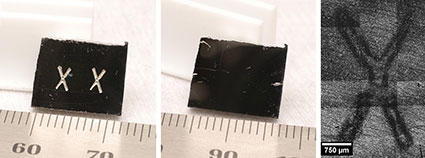
For an experiment to recover serial numbers that have been destroyed, NIST researchers hand-stamped X imprints into stainless steel (first image) to simulate a firearm serial number. Then they polished away the imprints (second image, scale bar in millimeters). Researchers recovered the imprints (third image) by combining pattern quality maps, calculated by software, which reveal crystal damage and deformation in the steel.
Researchers at the National Institute of Standards and Technology (NIST) have demonstrated a technique for mapping deformation in metals that can recover destroyed serial numbers on metal objects such as firearms, a common challenge in forensics.
The technique might also meet other forensic needs such as reconstructing vehicle identification numbers or imprints on ammunition casings, the researchers suggest.
Law enforcement agencies use serial numbers to track ownership of firearms and build criminal cases. But serial numbers can be removed by scratching, grinding or other methods. Analysts typically try to restore the numbers with acid or electrolytic etching or polishing, because deformed areas behave differently from undamaged material. But these methods don't always work.
As a possible alternative, NIST researchers used a technique called electron backscatter diffraction (EBSD) to read, in the crystal structure pattern, imprints on steel that had been removed by polishing. In EBSD, a scanning electron microscope scans a beam of electrons over the surface of a crystalline material such as a metal. The electrons strike atoms in the target and bounce back. Because the atoms are arranged in a regular pattern, the scattered electrons interact and form patterns that reveal the crystal's structure on a scale down to tens of nanometers. The more perfect the crystal structure, the stronger and clearer the pattern. Software can then calculate the pattern quality to reveal crystal damage; areas with more damage produce lower quality patterns.
In the NIST experiments, described in Forensic Science International, researchers hammered the letter "X" into a polished stainless steel plate. The letter stamps were as deep as 140 micrometers, meeting federal regulations for firearm serial numbers. The researchers then polished the metal again to remove all visible traces of the letters, and collected the EBSD diffraction patterns and pattern quality data and analyzed them for evidence of the imprints.
Ordinary SEM imaging methods revealed very faint outlines of the X stamps in the metal grains. However, pattern quality mapping more clearly revealed the outlines of the Xs, and according to the team, would probably be acceptable for submission as forensic evidence. The latter technique is significantly more sensitive to small amounts of crystal lattice damage.
The technique is still experimental, but shows some promise. The NIST team found evidence of metal deformation down to about 760 micrometers below the surface, much deeper than the actual X stamps. Even so, the researchers say it's not clear whether EBSD pattern quality mapping is more sensitive and/or more effective than conventional techniques for reconstructing serial numbers, or whether EBSD will work in cases of the most extreme destruction. Experimental comparison of the new technique to traditional techniques is under way.
Currently, the NIST method is time-consuming: A technician would need three full days to reconstruct an 8-character number. With further development and optimization, such as making pixel sizes larger in the images, recovery time probably could be reduced to about an hour, according to the researchers. The researchers suggest that wide adoption of this technology might enable manufacturers to place "hidden" sub-surface serial numbers on firearms—numbers that would be invisible to criminals but clearly detectable by law enforcement with this new analysis method.
The idea of using EBSD to recover firearm serial numbers was first proposed at a conference several years ago by Carl Necker of Los Alamos National Laboratory.
R.M. White and R.R. Keller. Restoration of firearm serial numbers using electron backscatter diffraction (EBSD). Forensic Science International. In press accepted manuscript. Published online Feb. 9, 2015. DOI: http://dx.doi.org/10.1016/j.forsciint.2015.02.003.

